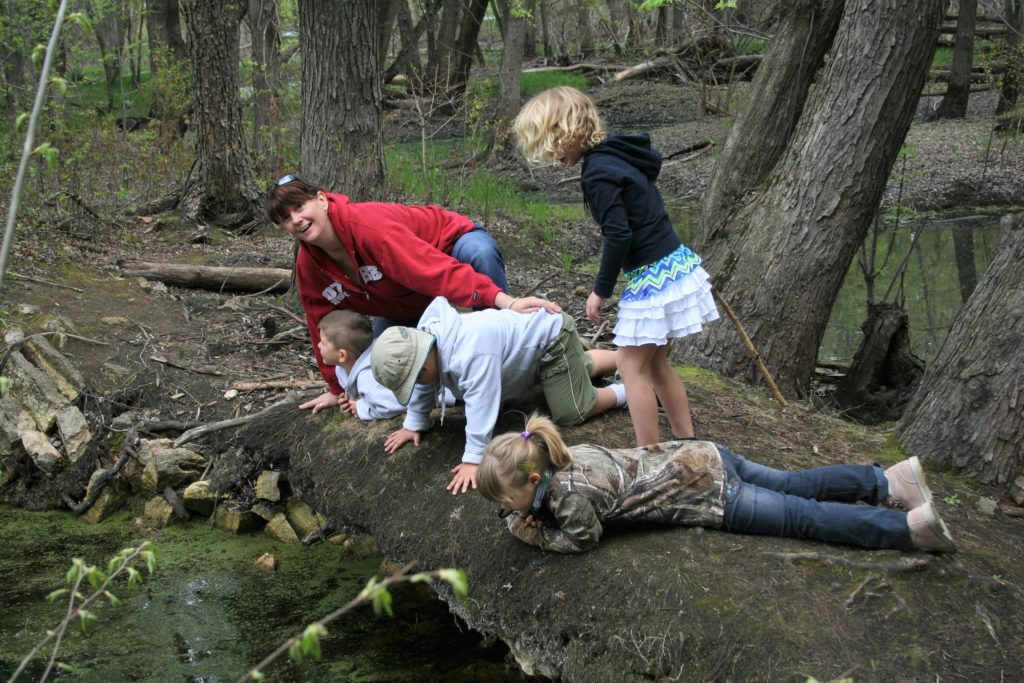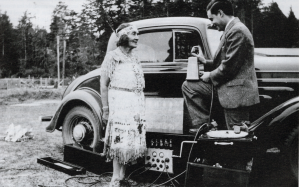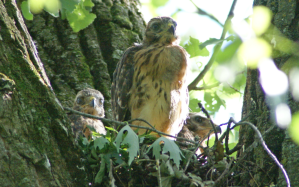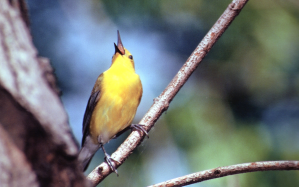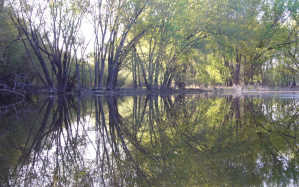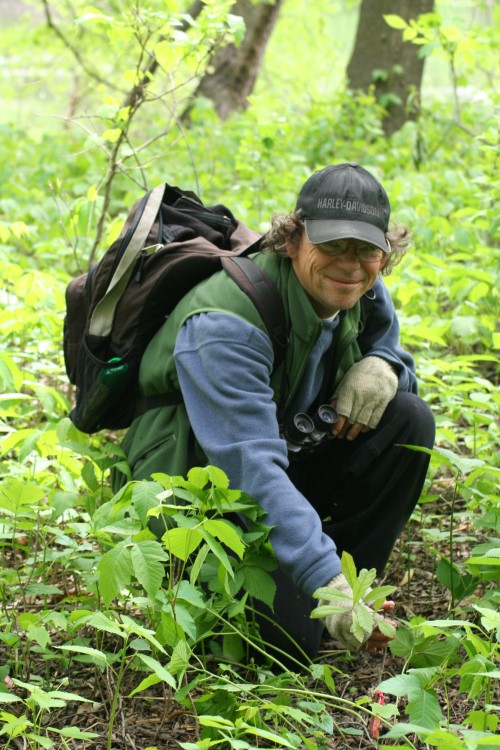PASSENGER PIGEON WALKS
Richie Swanson led spring walks along Prothonotary Trail at Aghaming Park and Preserve and wrote newspaper columns that advocated for the protection of Aghaming, 2008-2012. The Mississippi River Revival sponsored the efforts, which evoked the extinction of the passenger pigeon to call attention to contemporary threats to the wetland habitat, the red-shouldered hawk and other wildlife at Aghaming. The critical habitat is now managed as the “Aghaming Unit” of the Upper Mississippi River National Wildlife and Fish Refuge. The Mississippi River Revival, Winona Bird Club, Winona County Green Party, Aghaming Park Committee, City of Winona, Wisconsin Department of Natural Resources and United States Fish and Wildlife Service worked for the conservation success.
The newspaper columns and photos by Barbi Bell are archived below. The Mississippi River Revival is no longer an active organization.
FIRST ANNUAL PASSENGER PIGEON WALK 2008
(Copyright by Richie Swanson 2008)
Mississippi River Revival, sponsor
Mississippi River Revival invites you this Earth Day to remember one wildlife species already gone and to witness others amid critical habitat.
Flocks of millions of passenger pigeons once blotted the sun above the Mississippi, stretching from bluff-line to bluff-line, funneling like dark cyclones down to islands. Flocks turned trees slate-blue for miles.
One settler thought the massive flights sounded like a thousand venting steamboats, threshing machines and locomotives inside tunnels at once. Another sat quietly amid a nest colony and found the doves uncannily fearless, their din resembling “a mixture of sleigh bells and the rumble of an approaching storm.” Males cooed “bell-like wooing notes,” sidling against females, and both parents produced a milk-like curd inside their crops to feed one chick, which grew faster than any nestling today.
If passenger pigeons still existed, the wild doves might breed during late April at Aghaming Park and Preserve, so we’ll meet Saturday at the Wisconsin end of the Wagon Bridge for 90-minute walks at 10 AM and also 2 PM. Before we head to swamp white oaks and bulrush marshes, we’ll briefly gaze downriver, considering the passenger pigeon colony Zebulon Pike encountered as he returned from seeking the headwaters, 1806.
“The most fervid imagination cannot conceive their numbers,” he said. “Their noise in the woods was like the continued roaring of the wind.”
A white canoeist noted a September roost near Wabasha’s Prairie in 1836, and Lafayette Bunnell heard oak limbs crash from the immense breeding flock circa 1843.
Passenger pigeons bred at different islands and forests during different years, facing predators that remain at Aghaming today: mink, raccoons, peregrine falcons, owls, merlins, Cooper’s and sharp-shinned hawks.
Passenger pigeons did not defend chicks. They used an evolutionary strategy called predator satiation. Predators ate their fill while 90% of chicks successfully left nests, says Birds of North America Online.
Passenger pigeons were decimated during the late 1800s, when harvesters disrupted nest colonies until reproduction ultimately failed. People shot, netted, clubbed and smoked out the doves. They poked, shook and plucked tender-tasting squabs from nests.
The first historical record of a massive nest abandonment derived from a colony near Mankato, 1860. Islands below Wabasha hosted the final massive nesting on the Upper Mississippi, 1871. The last large nesting anywhere occurred in an el-shape 50-130 miles northeast of Winona, 1881.
One of the final railroad shipments to eastern food and trap-shooting markets left Sparta, Wisconsin in 1882.
We’ll also gaze at a quiet sandy road the city has considered protecting during the nesting season of snapping turtles, since vehicles have crushed eggs and turtles there. Snappers practice a reproductive strategy currently at risk. It’s the wrinkled old-timers, not young snappers, who reproduce best. The older and larger snappers become, the more eggs they lay.
Snappers may reproduce 60-100 years, but when adults die prematurely, young don’t rapidly fill the void like mice or rabbits. A snapper in Wisconsin may take 10-12 years to grow a shell large enough to mate, ten inches, said Robert Hay, Wisconsin DNR.
Snappers fall to plentiful hazards around Winona. Roads and railroads cause significant mortalities along the Upper Miss, and since females migrate to egg-laying sites without males, they suffer the largest losses, according to Mark Andersen, Wisconsin DNR. Riprap also foils turtles during travel. Smaller turtles especially get trapped between rocks and dehydrate or die other ways.
A busy highway near Aghaming–Highway 35–is a death trap in some locations” said Hay. Habitat loss, nest predation, commercial fishing and trapping probably reduce snappers even more than road mortalities.
We’ll look for early turtles and also rusty blackbirds, a species in 99% decline since 1966, according to the Patuxent Wildlife Research Center. Rusties foraged atop floating logs beside the path I call Prothonotary Trail last weekend.
Sunday may bring the trail’s namesake, the prothonotary warbler, a floodplain specialist in 40 percent decline since 1966. Ospreys may flap and flirt atop their nest, and if we’re really lucky, the state-threatened red-shouldered hawk might scream, or the spring’s first oriole may sing, or sandhill cranes may fly above a nest again.
The river shines uniquely during Earth Day, reflecting the velvety burgundy of emerging maple leaves, green shoots on purple blackberry stems, cottonwood-tops soft and brushy, chestnut-colored oak buds. Sunlight pours through a mostly-open forest onto mirror-like sloughs while warblers, waterthrushes and kinglets sing amid the flyway.
We’ll absorb the tones and hues, discussing how to conserve wildlife in a world of channelized rivers where only 10% of Midwestern floodplain forests remain.
Bring binoculars. Kids get first chance to ask and answer questions.
Info in this story derived from The Passenger Pigeon, its natural history and extinction, A.W. Schorger, and The Use and Conservation of Minnesota Game 1850-1900, E.B. Swanson. The story first appeared in the Winona Daily News, April 26, 2008.
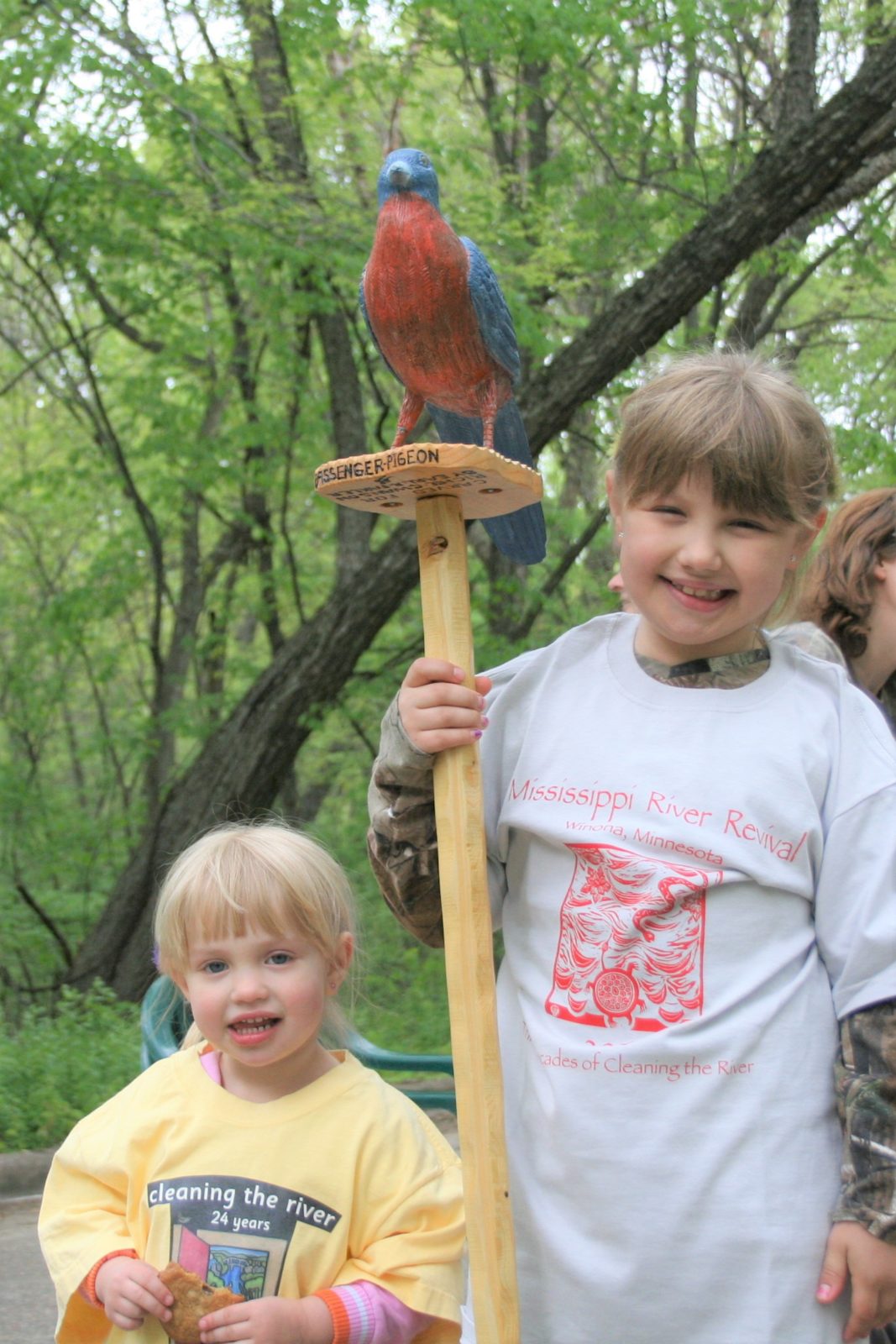
WALK OF RECONCILIATION 2009
(Copyright 2009 by Richie Swanson)
Mississippi River Revival, sponsor
John Latsch must be turning over in his grave, crying out painfully from the recent rape of habitat at his gift to Winona, Aghaming Park and Preserve. Off-road pickups, motorcycles and other vehicles have turned 25 acres of a sensitive wetlands, a floodplain forest, into a wasteland gouged with uncountable loops, ruts, spurs, damaged trees and pulverized logs. Vehicle scars indicate off-roaders have entered about 800 acres total, disturbing two historic territories of red-shouldered hawks during the time the state-protected species usually establishes nests.
Mississippi River Revival invites you to a “Walk of Reconciliation” starting at the Wisconsin side of the Wagon Bridge, Saturday March 14, 1:00 PM. Prepare yourself with mud-resistant footwear and the courage to witness a terrible assault. We’ll walk two miles roundtrip, visit the damaged site, share cookies and discuss how to reconcile our love of nature with needless destruction.
I will interpret the damage but also highlight habitat niches which can preserve species for future generations–as long as adequate protection prevails. The city currently allows vehicles virtually uncontrolled in the wetland forest December through February. It opens an old roadbed allegedly for ice-fishing access, but mud runners run recklessly, and since they displace soil which ends up in adjacent sloughs, fish habitat suffers.
We’ll visit sloughs where the build-up of sediments brought to the Mississippi by the forces of soil erosion has smothered vegetation, blocked out sunlight necessary for plant growth, and ultimately destroyed aquatic plant communities used as fish nurseries by bluegills, largemouth bass, and northern pike. We’ll visit sloughs used by the river’s most seriously declining duck, the lesser scaup, which winters off the Louisiana and Gulf Coasts in ocean waters that now include an ecological “dead zone” polluted by nitrates from intensive corn farming and other contaminants. We’ll also visit deep wallows of tire-scars in exact locations where North America’s most swiftly declining bird, the rusty blackbird, forages during migration.
The rusty blackbird winters in remnants of ivory-billed woodpecker habitat on the Lower Miss, relying upon aquatic insects and small fish in bottomland forests. It migrates through bottomland forests and swarms Aghaming during spring. Scientists estimate its population at less than two million, a 99% decline since 1966. The species ranges all the way east to the Atlantic, yet hundreds—sometimes thousands—occur at Aghaming daily late-March to mid-April.
We’ll visit a turtle hot-spot and turtle nursery, a woods where female snappers crawl full of eggs toward nest sites, a road where vehicles crush the female snappers, a sandy bank where vehicles destroy eggs.
We’ll peer up at granddaddy cottonwoods, fishing perches for eagles and tall-tree nest-niches for North America’s most swiftly declining warbler, the cerulean, sometimes a breeding bird at Aghaming. We’ll visit granddaddy oaks, food source for the acorn-loving wood ducks, deer, red-headed woodpecker etc. We’ll look again at tire ruts. Exotic species—buckthorn, honeysuckles, canary grass–will likely grow in the scars, preventing the regeneration of the oaks, cottonwoods and other forest trees, the best assets nature has to sequester carbon and battle global warming.
We’ll wander to one bank where tire-scars invite purple loosestrife and to another where the river in its artificial channel cuts beneath upturned roots, eating an island. We’ll consider why Winona enables vehicles to hasten the erosion and demise of islands while taxpayers spend millions of dollars each year to build them on the Upper Miss.
The sign beside the gate intends to control traffic on the old roadbed at Aghaming, but it speaks doublespeak. Though the gate exists to close sensitive habitat to driving, the big letters say ROAD OPEN. The tiny letters say December 1 to March 1. The big letters of the sign next to it say CRITICAL HABITAT. If you switch two words, you unfortunately get an accurate picture—OPEN ROAD in CRITICAL HABITAT.
The gate intends to protect the red-shouldered hawk and the floodplain forest, both about 90% gone. The gate has been left open after March 1 for the second consecutive year. It’s also so flimsy pickups bash right through it, even though citizens previously offered $1400 to buy the best gate in the wildlife business.
But neither the gate nor ice-fishing is the real problem. Neither the 1998 Aghaming Park Plan nor the 2005 Aghaming Trail System Plan recommended motorized traffic anywhere downriver from the Wagon Bridge Road. I worked on both projects, and as I remember things, intelligent experts recognized a long history of vehicle abuse at Aghaming, and the need for trails, not traffic in a wildlife-rich environs.
The city lacks the political will, expertise and money to responsibly manage and enforce cars, trucks, motorcycles and four-wheelers in sensitive habitat. It should respect Latsch’s gift by keeping vehicles altogether out of the wetland woods and marshes during the entire year.
Richie Swanson sometimes works for the Mississippi River Revival, which currently advocates for Higgins Eye Pearlymussel, blufflands, clean water, river cleanups. This story appeared March 14, 2009 in the Winona Daily News.

SECOND ANNUAL PASSENGER PIGEON WALK 2009
(Copyright 2009 by Richie Swanson)
Mississippi River Revival, sponsor
North America’s most swiftly declining bird struts these days like a pint-sized crow at Aghaming Park and Preserve. Rusty blackbirds balance themselves on floating logs, tapping and probing bills into old wood for insects, searching for insect-prey to fuel migrations to nest-sites as distant as northwestern Alaska. You hear blackbirds squeaking like wet-rusty hinges, rattling like broken glass, whistling screechy koo-a-lees, you hear a species 99% gone since 1966, once counted by the millions during Christmas Bird Counts, now rarely by the thousand.
Mississippi River Revival invites you to experience the “rusty” at our second annual Passenger Pigeon Walk, Saturday April 18. Meet at the Wisconsin end of the Wagon Bridge either at 10:00 a.m. or 1:00 p.m. I’ll briefly discuss the passenger pigeon’s local history, then we’ll walk 90 minutes through floodplain forest to marshes, scoping waterfowl and an osprey nest, visiting other habitat niches. We’ll also provide trash bags for removing litter after walks.
Passenger pigeons vanished as American settlers deforested the landscape, over-hunted the doves and shipped them by railroad to big-city markets. But today rusty blackbirds give us a chance to succeed at preservation and avoid extinction. During the 19th century passenger pigeons nested in massive colonies on the upper Mississippi, darkening the air as they arrived, sounding like roaring locomotives in the sky. Nest colonies turned islands slate-blue for miles, and naturalists counted hundreds of nests per tree and 1500 nests while standing in the same spot.
Indians and settlers struck nest-trees with clubs, and chicks fell like apples. Settlers gunned them easily from bluff-tops, fields, cabins and especially at nesting grounds. One hunter harvested 60,000 chicks in a year. Others piled them in wagons and paraded them through Chatfield, holding “camp-meetings for epicures,” celebrating pin-feather hash, chicks stewed in whiskey sauce, pigeon pies.
Settlement forced the pigeons into marginal habitat, depriving them of sufficient food and adequate numbers to reproduce. Today, the rusty blackbird faces some similar problems, some different. Rusties winter on the lower Mississippi, using depleted remnants of once-gigantic forests, and they rely upon Aghaming’s floodplain forest on their way north, an ecosystem 90% gone. They toss away leaf-litter like unwanted trash, clutching sticks with claws, probing bark and soil for worms and other larvae. They cling to the bases of flooded trees, snatching bugs, and they wade into sloughs, ducking heads underwater for crayfish and snails, emerging with darting-yellow eyes.
Rusties build stick-nests amid beaver ponds, bogs and other northern shores. They’re absent from vast regions where they once bred abundantly, partly because logging, gas and oil development, peat production, hydroelectric projects and agriculture usurp habitat. Global warming evidently dries up their wetland nest-territories, perhaps changing the availability and composition of aquatic-insect prey. Mercury may contaminate small-fish and insect prey. Acid rain may deplete calcium in soil and insects necessary for egg production. Blackbird control programs—poisoning agricultural pests on wintering grounds—may also have diminished the rusty in the past.
Depressing? Remember, Aghaming supports raptor populations once decimated by DDT. Last year’s walk witnessed ospreys mating, bald eagles soaring, and a peregrine falcon harassing a great-horned owl. Rusties, sandhill cranes and the river’s most seriously declining duck, the lesser scaup, also appeared in protected wetlands.
We’ll hope to see a snapping turtle Saturday—not on a dangerous highway or in riprap where it can dehydrate or in a fish net headed for Chicago’s soup market—but in a sleepy slough where a hooded merganser rests on a log-sweep, watching her nest-hole high in a maple. We’ll hope for a crayfish’s mud chimney, smells of mink musk, and the dazzling glimmer of dragonflies, favorite food of Aghaming’s rare yellow-headed blackbird colony.
We’ll visit an oak where declining yellow-billed cuckoos pass twigs over shoulders in mating rituals similar to those passenger pigeons performed. We’ll even hope for Aghaming’s long-lost woodpecker, the red-headed, which vanished mysteriously from a granddaddy grove during breeding season two years ago.
A common sparrow will certainly sing, reminding us how marvelously humans can solve mysteries. Computer sonograms have revealed “our” eastern song sparrows sing differently than west-coast populations. One population learns songs by matching neighbors’ song-phrases exactly, the other by mixing them up. One population migrates, the other doesn’t. Can you guess which learns by precise mimicry? And why?
Few would have guessed the crucial value of John Latsch’s gift when he gave it 75 years ago, so come muddy your boots and see what Earth Day cultivates inside you. Please, bring kids and binoculars.
Info in this story derived from The Passenger Pigeon, its natural history and extinction, A.W. Schorger, The Use and Conservation of Minnesota Game 1850-1900, E.B. Swanson, Birds of North America Online, Birder’s Conservation Handbook, Jeffrey Wells, and the Migratory Bird Center. The story first appeared in the Winona Daily News, April 2009.
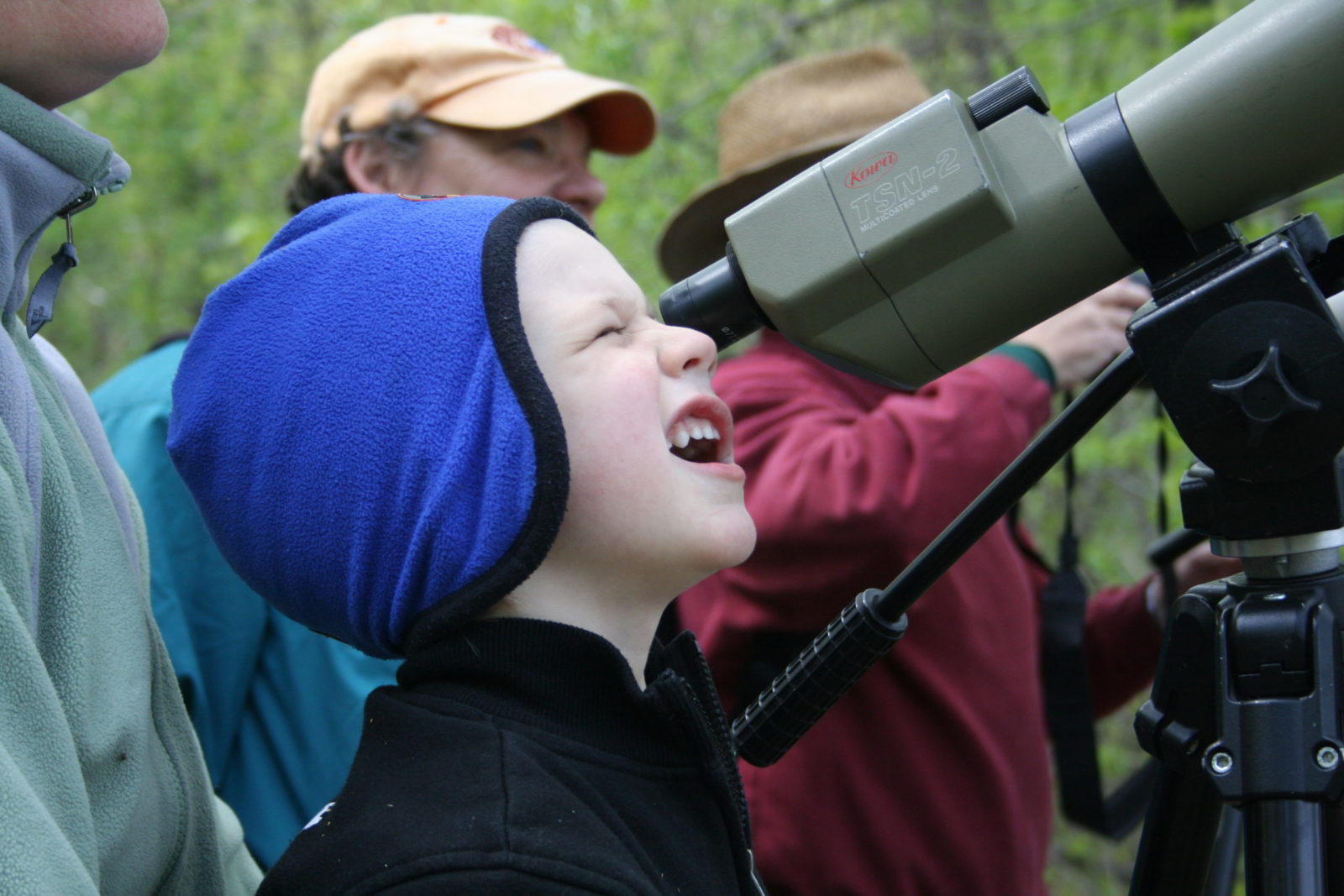
THIRD ANNUAL PASSENGER PIGEON WALK 2010
The floodplain and land stewardship
Mississippi River Revival, sponsor
(Copyright 2010 by Richie Swanson)
As Lafayette Bunnell canoed near La Crosse about 170 years ago, something crashed in heavy timber and boomed like “the letting off of steam.” “Limb after limb” fell as millions of passenger pigeons crowded onto tree-perches at a nest colony stretching 45 miles downriver. Since the doves grew extinct as farms deforested wooded habitat, and the Mississippi currently flushes overloads of sediment into the Gulf of Mexico, the third annual Passenger Pigeon Walk will envision clean water and erosion-free agriculture while recalling doves filling skies above Wapasha’s Prairie.
Meet at Aghaming, the Wisconsin end of the Wagon Bridge, 10:00 A.M. and 1:00 P.M. I’ll share passenger-pigeon history and lead 90-minute walks hosted by the Mississippi River Revival and Land Stewardship Project, a nonprofit network who advocates sustainable farming. We’ll visit secret habitat niches—one hole from which hooded merganser chicks leap 50 feet down into backwaters–another sometimes used by luminous warblers from mangrove swamps–a third chiseled by sap-thirsty woodpeckers shadowed by hummingbirds.
We’ll seek the rusty blackbird, a species in 95-99% decline, who forages Aghaming by the thousands. We’ll hopefully scope lesser scaup, ducks who struggle to find food from the Zone of Hypoxia at the river’s mouth to nitrate-polluted wetlands in the Upper Midwest. We’ll also visit sloughs which grow filmy with soupy-green goop by August, and discuss runoff impacting food webs here and in the gulf.
Nitrates concentrate in the upper Mississippi at levels ten times greater than pre-development times, and phosphorous in Lake Pepin, four times greater, says a new scientific paper co-authored by Dr. William Richardson, aquatic ecologist at USGS Upper Midwest Environmental Sciences Center.
Row-crop corn and soybeans are the largest source of nitrogen, derived mostly from synthetic fertilizers, nitrates, says Richardson. Animal manure—pasture, range, feedlots—contribute the most phosphorous. The nitrogen and phosphorous flow downriver and help cause detrimental algae blooms that deplete oxygen in the Gulf of Mexico. The upper Mississippi contributes about one-third of the nitrates and phosphorous to the gulf, helping to kill and diminish organisms such as snails, mollusks, crabs, starfish and worms.
“Elevated levels of nitrogen and phosphorous also change oxygen content in upper Mississippi backwaters, causing swings during late summer that bottom out so low that shrimps, zoo-plankton, crustaceans and other invertebrates can suffocate from lack of dissolved oxygen,” says Richardson. “Increases in phosphorous and nitrogen can cause blooms of blue-green algae that are toxic and difficult to eat. Inedible algae can dominate, and algae-eating bugs and shrimps can literally die in a sea of green. The problem with dead bugs and shrimp is these animals form the base of the river’s food chain.”
“Agriculture doesn’t have to pollute water,” says Doug Nopar, staff, LSP. “Crop rotation can prevent nitrogen runoff. Rather than mono-cultures of corn, plant maybe oats and barley one year, then corn, soybeans, maybe corn again, then alfalfa and oats. Alfalfa fixes nitrogen to soil one year. Plant corn the next, it doesn’t need fertilizer.”
“The crux of reducing runoff is high soil life,” says Duane Hager, a farmer in Kellogg. “Healthy soil is loose and crumbly and absorbs rain, so the nutrients stay where they are.” Hager says LSP helped give him direction after he bought rundown land. He controls weeds by cultivation, not chemicals. He adds natural minerals to soil, and after he harvests corn, he likes to sow densely-rooted rye as winter cover, an alternative to bare winter fields exposed to spring rains. Hager grows 200 acres of corn in contour strips and raises beef and dairy cattle by rotating pastures.
“Rotational grazers control manure runoff by mimicking buffalo herds, who would forage at one place, leave, allow regeneration and return much later,” says Nopar. “Farmers can feed livestock grass instead of row-crop grains. Break up pasture into managed paddocks, let livestock graze a day or two, move them and return to paddocks in about a month. This spreads out and limits manure, encourages livestock to eat diversely and lets plants grow and retain roots and moisture, so the manure’s nutrients sink into soil and don’t end up in backwaters or the hypoxia zone. Cows don’t stay in barns, so farmers don’t burn so much transportation fuel hauling away manure or delivering feed.”
LSP facilitates free-market profits. It connects, for example, organic dairy farmers with organic corn growers and locally-raised foods with local schools. Caroline van Schaik, LSP staff, has also helped initiate wildlife monitoring, measuring impacts of delayed hay cuts, rotational grazing and other conservation practices on grassland birds like bobolinks and dickcissels.
Van Schaik will walk with us, answering questions. We’ll scope an osprey nest, proof agriculture can co-exist with the floodplain’s endangered species, thanks to the DDT ban. Please, bring kids and binoculars.
Info in this story derived from History of Winona County, H.H. Hill, Birder’s Conservation Handbook, Jeffrey Wells, www.RiverBirdBlog.com and www.landstewardshipproject.org. The story first appeared in the Winona Daily News, April 2010.
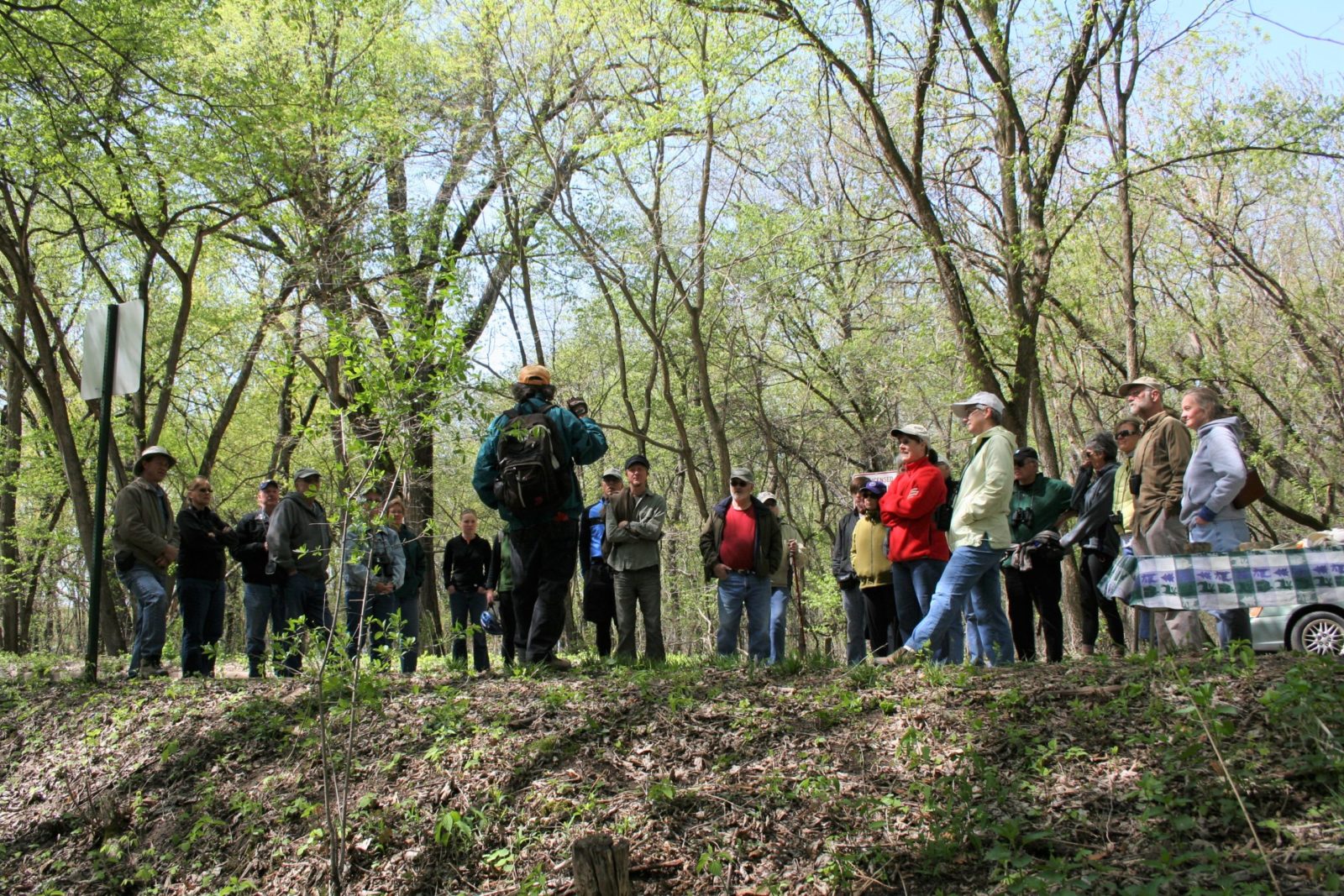
FOURTH ANNUAL PASSENGER PIGEON WALK 2011
Deepwater Horizon and Aghaming birds
(Copyright 2011 by Richie Swanson)
Mississippi River Revival, sponsor
During last year’s Passenger Pigeon Walk, prospects for wildlife seemed bright at Aghaming Park and Preserve. Participants saw America’s most swiftly declining bird, rusty blackbirds, and ospreys displaying on a nest, continuing to rebound from near-extinction. We tiptoed to turtle sites, where ancient creatures basked in sun, restoring food stores after spending winter frozen in mud. Three days later, red-shouldered hawks were confirmed breeding deep in Aghaming where off-road vehicles had overrun the floodplain forest the previous year.
Citizens and government had worked hard together, insuring vehicle-free habitat for the state-threatened hawk in 2010. Now a mama red-shoulder hunkered down in a cottonwood-crotch, incubating eggs nearly invisibly, just as her needs demanded. But 12 hours later the Deepwater Horizon well exploded in the Gulf of Mexico.
By the time red-shoulder chicks poked fuzzy-white heads above the nest-rim, oil had spewed three weeks. It continued four weeks later as three young hawks stood with creamy-mottled breasts, flexing wings, itching to fly. Oil continued to spill six weeks after red-shoulders vacated the nest, while fledglings of great blue herons and other gulf-bound species stored calories here before flying south.
Mississippi River Revival hosts the fourth annual Passenger Pigeon Walk Saturday, April 30. Please, bring kids and binoculars. We’ll meet at the Wisconsin end of the Wagon Bridge 11:00 a.m. and 1:00 p.m. I’ll briefly evoke passenger pigeons during the 19th century. We’ll walk 90 minutes, a one-mile roundtrip on a muddy trail requiring boots. We’ll seek snapping, map, painted and soft-shelled turtles. I’ll also identify vegetation and niches crucial for bird species who must overcome the BP disaster.
Here, white pelicans school fish, great egrets stab frogs, green herons possibly drop bark-bits as bait. Here, common loons and state-endangered Caspian and Forster’s terns fish during April; yellow-billed cuckoos pass twigs, mating; least bitterns weave fishing platforms. Here, black terns flew fish-flight displays, and yellow-crowned night herons once performed stick-fidgeting rituals, nesting before flying south to live on inter-tidal crabs. These and other Aghaming species were found dead and oiled by Deepwater Horizon, according to wildlife collection data, U.S. Fish and Wildlife Service.
We’ll likely scope lesser scaup and other waterfowl who rely upon the gulf–a damaged ecosystem even before the spill. Row-crop corn, soybeans, feedlots and other sources already overload the Mississippi with nitrogen and phosphorous and help create hypoxia in the gulf, crippling food chains. The gulf’s coastal marshes already lose a football field of acreage every 38 minutes—because climate change raises sea levels, oil and gas industries carve channels through marshes, and levees near the Mississippi’s mouth curtail the replenishment of silt.
Science may never completely understand the impacts of oil upon shrimp nurseries, coral reefs, plankton communities, fisheries, sea turtles, shorebirds and seabirds. But Winona-area conservationists can help now, supporting habitat protection here. Nearly 13 million ducks and geese use the gulf some winters, says Ducks Unlimited. Some breed here. Millions more rely on our wetlands as they continue north. About 40 percent of North America’s waterfowl use the upper Mississippi, says U.S.F.W.S.
We’ll walk down Prothonotary Trail, gazing at Cerulean Woods and Solitary Slough, places named for two disappearing warblers and a struggling sandpiper who rely upon habitats around the gulf before breeding and migrating here. We’ll envision how abundantly passenger pigeons used the river.
While exploring the Mississippi during 1806, Zebulon Pike found their numbers on an island too numerous too imagine. Lafayette Bunnell saw “numberless” near La Crosse circa 1842. In 1853 David Taber, a 14-year old flagman for the Government Survey, arrived at Red Wing from Vermont. A Dakota chief took him upriver to “the finest pigeon pass in the West” to learn to use a rifle. Twenty years later, Taber took his son Ralph ten miles into Wisconsin to a nest colony. Ralph described the outing in 1915 in St. Nicholas Magazine. “Greatly to father’s disgust, we found over a score of settlers’ wagons scattered through the woods.” Men and boys climbed into trees, clubbed and shot chicks and parent birds until “wagons were all loaded with loot.”
“I tried to reason with some of those robbers, but it was useless,” said Ralph’s father. “I wish I might get a law passed…I very much doubt if any of the birds return again.” The last nest colony on the upper Mississippi occurred, 1871. The last passenger pigeon died, 1914.
We might feel David Taber’s pain this Saturday, but we’ll also venture hope, walking amid glistening blue waters and beautiful bluffs, listening to bottomland that helps to mitigate the ugliest oil spill in history, nearly 500 million barrels. We’ll celebrate John Latsch’s gift where turtles, fish, birds, dragonflies and other miracles sustain themselves, so great grandchildren might appreciate them too.
Richie Swanson, www.WarblingRichie.com, has documented red-shouldered hawk nests at Aghaming since 1994. Info in this story derived from Matter Network, Nature News, The Passenger Pigeon by A.W. Shorger, and “Nitrogen and phosphorus in the Upper Mississippi River: transport, processing, and effects on the river ecosystem,” Hydrobiologia 2010, Jeffrey N. Houser and William B. Richardson. The story appeared in the Winona Daily News, April 2011.

FIFTH ANNUAL PASSENGER PIGEON WALK 2012
(Copyright 2012 by Richie Swanson)
Mississippi River Revival, sponsor
The fifth annual Passenger Pigeon Walk commemorates one bird forever gone from the Mississippi and another at Aghaming Park and Preserve which may benefit from a new endangered species listing.
Mississippi River Revival offers two walks Saturday, meeting at the Wisconsin end of the Wagon Bridge 10:00 a.m. and 1:00 p.m. I’ll briefly evoke passenger pigeons during the 19th century, and we’ll walk one-mile roundtrip, 90 minutes, and visit breeding habitat previously used by the new candidate for protection under Wisconsin’s Endangered Species Act, black terns.
Male passenger pigeons—toms—performed “grand wing” displays for hens in the river bottoms until 1871. They perched beside hens, wings flapping, clapping above their backs, slapping branches. Their bodies rose and fell with each stroke, and sometimes millions carried on simultaneously, clucking, creating a raucous rumbling at chains of pigeon-blue islands up to 40-miles long.
Mating lasted about three days, says A.W. Schorger in The Passenger Pigeon: Its Natural History and Extinction. Then toms swarmed the ground for nest-twigs, flew up onto hens’ backs and passed twigs into hens’ bills.
Fortunately black terns still perform courtship rituals at one of Aghaming’s remote marshes. They fly herky-jerky flights as high as the bluffs in May. Males catch fish and dragonflies from Aghaming’s wetlands and fly across a property line to one of the tern’s largest colonies left in Wisconsin. Males approach females, dangling minnows, and if one gets ignored, he sometimes drops his prey and catches it again. After a female accepts his offering, each tern points its bill high, gurgling and rattling urgent messages of pair bonding. Black terns also bring food from Aghaming to nestlings.
We probably won’t see a black tern as we walk beside Osprey Marsh, where terns nested during the 1990’s. But we’ll scope ospreys, who have rebounded so well from DDT their state-threatened status has been dropped.
Not only did humanity almost poison ospreys to extinction. We also once suspected its females of trading you-know-what for fish, which males deliver in screaming fashion, flying in slow descents above females at nests, showing off fish in talons before mating.
We’ll provide extra binoculars, so bring kids, please. We’ll view a beaver lodge built during last year’s flood. The lodge and nearby dikes illustrate how humanity has changed the Mississippi. Dietland Muller-Schwarz in The Beaver claimed beaver ponds covered 11 percent of the upper Mississippi’s watershed in 1600.
We hope to view sandhill cranes and great egrets (saved by hunting regulations and wetland protection in the early 1900s) and rusty blackbirds (99% diminished, apparently suffering global warming). We’’ll walk through floodplain forest 90% gone since European settlement–spring habitat teeming with songbirds, mink disappearing beneath nettles, groundhogs munching leaves, turtles basking in sloughs.
Aghaming’s forest provides a niche for the state-threatened red-shouldered hawk, who hunts along Prothonotary Trail these days. Red-shoulders prefer invisibility. They’ll probably vanish before we see them. Like terns and ospreys, they perform unique courtship rituals. Males fly tight circles above forest canopies, shrieking super-loudly, and females coax them down with muted cries, waiting quietly on perches.
Red-shoulders nest currently in woods once used by off-road vehicles–a major deterrent for the hawk. The city secured these woods from motorized traffic several years ago, putting up signs and barriers. Red-shoulders have taken advantage of the protected habitat, breeding at the particular site for the first time, I believe.
Unfortunately off-roaders continue to risk forest regeneration along the winter access road to Sam Gordy’s. Though the road runs through wetlands, the city tries to allow motorized traffic December through February. But no signs or barriers exist to keep vehicles out, and off-roaders entered the wetland forest seven different places this year, including fragile ground supporting old-growth oaks. Vehicles broadened an uncontrolled parking area and spun deep ruts where MRR held the Reconciliation Walk in 2009.
The cooperative agreement between the city and U.S. Fish and Wildlife Service to manage Aghaming should come to City Council soon. The off-road damage and black terns symbolize its necessity.
Black terns winter as far south as Peru and depend upon declining fisheries and insects impacted by insecticides during migration. They breed in marshes mostly drained from North America, further threatened by exotic carp, loosestrife, canary grass and sediment overloads. Boat wakes, floods on channelized rivers and human-friendly predators like raccoons destroy their nests.
Their favorite habitat at Aghaming adjoins a crucial colony already protected by USFWS. Call it a prophetic partnership, geography and nature predicting a bureaucratic union. But the last time I heard a tern beg, I thought she lobbied for her brood, ample resources for a future generation.
The cooperative agreement should help humans do the same for their descendants, enabling great-grandchildren to learn first-hand and love the same wildlife diversity we cherish today.
Richie Swanson has monitored red-shouldered hawk nests at Aghaming since 1994. Info in this story derives from the Wisconsin DNR and Birds of North America Online.
